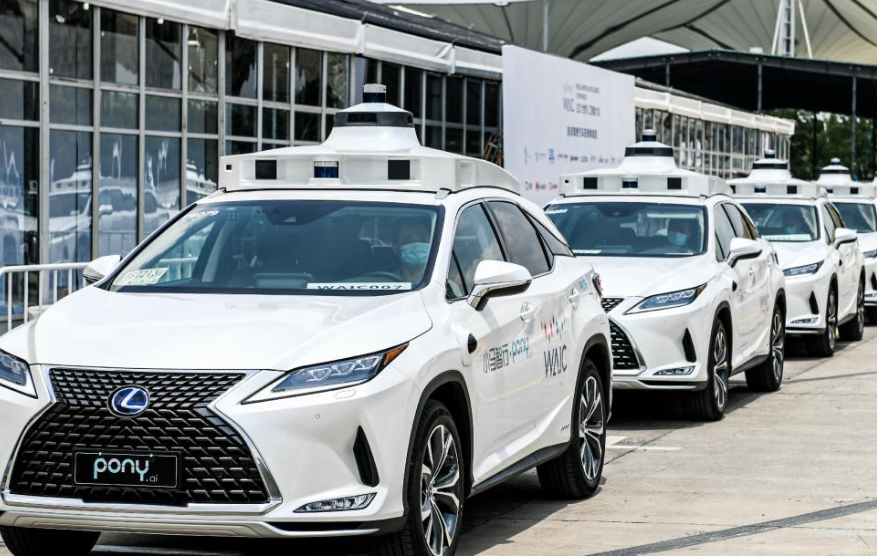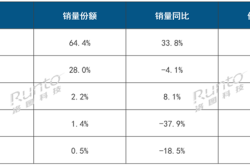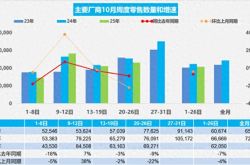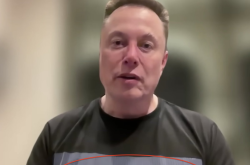"China Red" Stands Out Amidst US Stock Market Decline: Uber Joins Forces with China's Dual Titans to Accelerate Robotaxi Commercialization
![]() 05/08 2025
05/08 2025
![]() 498
498
The US stock market witnessed an unusual surge in Chinese stocks, defying the overall market trend.
On May 6, 2025 (EST), the three major US stock indices closed lower, with most large financial and technology stocks declining, dragging down the performance of the US stock market.
However, amidst this backdrop, Chinese autonomous driving companies Pony.ai (PONY.OQ) and WeRide (WRD.OQ) shone brightly. Pony.ai surged over 47%, leading the market gains, while WeRide also soared by 31.68% in a single day. Most popular Chinese stocks ended the day in the green, with the Nasdaq China Golden Dragon Index up 0.42%, outperforming the broader market.
The catalyst for this capital preference was the announcement by both companies on the same day of their strategic cooperation with global ride-hailing giant Uber. WeRide plans to deploy Robotaxi services in 15 additional international cities over the next five years, while Pony.ai's Robotaxi services and fleet will be the first to be integrated into the Uber platform in the Middle East market in the second half of the year, accelerating the commercialization of autonomous driving technology.

From the UAE to Europe: WeRide Conquers Uber with "Desert Autonomous Driving"
As the only Robotaxi enterprise globally with autonomous driving licenses covering all vehicle types nationwide in the UAE, WeRide's cooperation with Uber began in September 2024.
In December of the same year, the two companies launched the public operation of Robotaxi services in Abu Dhabi, officially commencing commercial operations.
This marked the first time that Uber, the world's largest mobile travel and delivery technology platform, had introduced autonomous vehicles outside the United States. It was also the largest commercially operated Robotaxi fleet outside the US and China. At that time, the two parties planned to expand the fleet size to 50 vehicles by the middle of 2025.
In April 2025, the two companies successfully expanded their cooperation to Dubai, demonstrating WeRide's autonomous driving technology's adaptability to high-temperature and sandy environments.
According to the upgraded agreement reached by the two parties, they have committed to deploying Robotaxi fleets and services in 15 additional international cities outside China and the United States over the next five years. This expansion will cover WeRide's established presence in the Middle East and the European market, which faces challenges of aging populations and labor shortages.
WeRide will provide L4 autonomous driving vehicles, while Uber will handle fleet operations and user access.
Since its inception in 2010, Uber has provided over 58 billion rides. More importantly, its customer base and growth potential are immense. As of the end of 2023, Uber had 150 million end-users globally, and based on customer acquisition trends over the past five years, it has added nearly 11 million new customers annually.
WeRide, as the "first global Robotaxi stock," has conducted autonomous driving research and development, testing, and operations in 30 cities across 10 countries globally, according to incomplete statistics. It is the only technology company globally with autonomous driving licenses in China, the UAE, Singapore, France, and the United States, and boasts over 1,000 L4 autonomous driving vehicles.
Some market self-media interpreted that, based on an average Robotaxi penetration rate of around 20% in each city over the next five years, WeRide, with its 15 additional operating cities in collaboration with Uber, is expected to scale up the deployment of global Robotaxi to hundreds of thousands, serving tens of millions or even hundreds of millions of end-users.
For WeRide and Uber, which have collaborated before, this upgraded cooperation implies that the previously attempted "technology + traffic" business closed loop is highly feasible. Expanding the scope and scale further signifies that the commercialization prospects of new Robotaxi services are becoming increasingly clear.
Uber CEO Dara Khosrowshahi said, "Today, we are announcing an unprecedented strategic cooperation in the field of autonomous driving, marking a crucial step towards popularizing autonomous driving services in more cities globally." "Relying on Uber's global network, operational experience, and leading platform technology, we are delighted to join hands with top autonomous driving technology companies like WeRide to expand the commercialization of autonomous vehicles."
Uber's financial report shows that its revenue in 2024 increased by 18% year-on-year compared to 2023. Fourth-quarter revenue exceeded expectations, increasing by over 20.36%, with total orders reaching $44.2 billion, up 18% year-on-year, an impressive performance.
During the same period, despite overall revenue pressures and widening losses for WeRide, its sales of autonomous driving kits grew significantly, with annual product revenue increasing by 61.8%, indicating a gradual enhancement of its capability to export technological solutions externally.
Apart from its cooperation with Uber in the Middle East market, in March 2025, WeRide's Robotaxi services were approved for toll operations between the Beijing Economic-Technological Development Area and Beijing South Railway Station, marking its first entry into the core transportation network of a first-tier city, laying the foundation for subsequent large-scale toll operations. Concurrently, the company launched Spain's first trial ride service for pre-installed mass-produced autonomous driving minibuses on public roads in Barcelona, verifying its technological capabilities in complex urban scenarios in Europe.
Supported by certain effective commercial achievements, the market gave strong positive feedback after news of this cooperation emerged, causing Uber and WeRide's US stock prices to soar.
First Collaboration with Uber Adds Another Member to Pony.ai's Global Mobility Traffic Network
While both are among China's top autonomous driving companies, WeRide and Pony.ai exhibit significant differences in their business approaches. The former is more of a "landing-priority" localized enterprise, while the latter, leveraging the advantage of its full-stack self-developed L4 system, resembles a "technology-driven" global player. The commonality lies in the strong emphasis on global market layout by both companies listed in the United States.
Pony.ai's stock price surged even more than WeRide's, partly because this is its first strategic cooperation with Uber, and the news had a greater stimulating impact.
According to the announcement, the two parties plan to integrate Pony.ai's Robotaxi services and fleet into the Uber platform in the second half of 2025, promoting the commercial application of autonomous driving technology in the travel sector.
This cooperation will initially be launched in the Middle East market and gradually expand to more overseas regions. By then, users can choose autonomous vehicles provided by Pony.ai to complete their journeys when booking rides using the Uber app.
On the technical front, Pony.ai's seventh-generation automotive-grade autonomous driving system, unveiled at this year's Shanghai Auto Show, is the world's first solution to achieve L4 full-scenario unmanned driving capability based on automotive-grade chips. This system solution employs 100% automotive-grade components, including solid-state LiDAR and NVIDIA Orin-X chips, with a design life of up to 10 years or 600,000 kilometers. Simultaneously, based on the PonyWorld world model technology, the L4 Robotaxi fleet has achieved 500,000 hours of full-scenario, fully unmanned operations, with safety 10 times higher than human driving.
Pony.ai stated that this system solution enables full-scale automotive-grade mass production of Robotaxis, providing strong support for this cooperation. This technological upgrade aligns perfectly with the goal of both parties to promote the implementation of autonomous driving services.
Pony.ai's co-founder and CEO, Peng Jun, candidly said, "By combining Pony.ai's mature autonomous driving system with Uber's leading mobility platform, we will start in the Middle East market and expand globally, setting a new benchmark for the commercialization of unmanned driving."
In fact, Pony.ai's autonomous driving services currently launched in multiple cities in China have been operating stably, especially in first-tier cities such as Beijing, Shanghai, Guangzhou, and Shenzhen. Its fully unmanned Robotaxi services have covered complex and diverse road conditions ranging from bustling downtown business districts to airports and high-speed railway stations, accumulating over 45 million kilometers of autonomous driving experience.
This provides a rapidly replicable and implementable "model room" for technology, policy, and commercialization for its overseas markets. To accelerate the commercial operation of its Robotaxi in major cities globally, the company already has the most ride-hailing and taxi platform partners among global Robotaxi companies.
Apart from Uber, partners also include WeChat Travel Services, Ruqi Travel, Alipay, Gaode Maps, Singapore's ComfortDelGro Group, and Luxembourg's Emile Weber, among others, bringing a broad user base and access channels to Pony.ai's autonomous driving services.
When Chinese technology meets the Uber platform, will Robotaxi commercialization usher in an "exponential explosion" inflection point?
The content of the cooperation between Pony.ai, WeRide, and Uber reveals that with the leading transformation in electrification and intelligence, China has quietly transformed from a "technology importer" to a "technology exporter," and a group of Chinese AI companies are shining globally.
Uber CEO Dara Khosrowshahi said, "Our collaboration with Pony.ai is an important step in promoting autonomous mobility services globally. As a leading service platform covering travel, delivery, and freight within the industry, Uber will leverage its unique advantages to jointly accelerate the commercialization process of autonomous driving with Pony.ai."
In fact, apart from Pony.ai and WeRide, Baidu's Robotaxi service, Apollo Go, also recently announced its landing in the UAE, while Waymo is testing the waters in the Japanese market. On May 2, Chinese autonomous driving company Momenta also announced a partnership with Uber, planning to introduce autonomous vehicles to the Uber platform, with the first batch of commercial cooperation set to launch in Europe in early 2026.
Obviously, China's Robotaxi sector is fully ramping up its efforts in overseas markets. More importantly, among the many players rushing to make all-out efforts, 2024 has effectively become the first year for the commercialization of Robotaxi, and preliminary results show that large-scale operational profitability in this sector is promising.
The promotion of this cooperation between industry giants seems to indicate that the industry is entering a critical turning point from "technology scale verification" to "commercial value realization." Chinese players with prominent technological first-mover advantages are seizing the opportunities arising from the global autonomous driving industry, participating in the formulation of industry rules, and reshaping the global industrial division of labor with technology.








